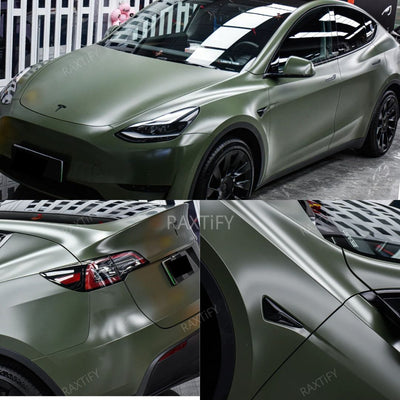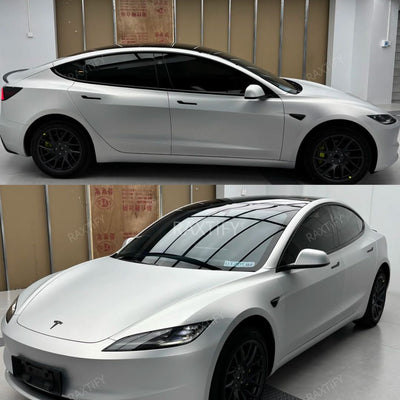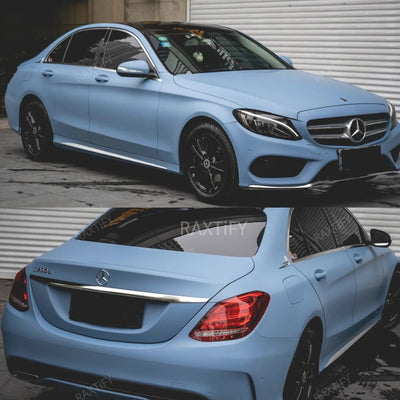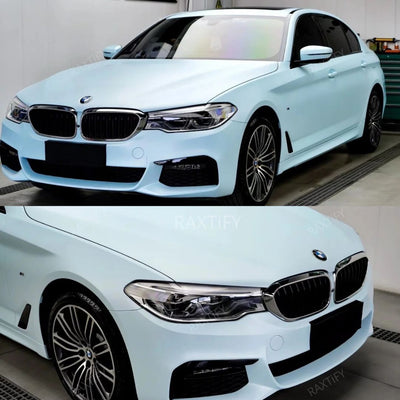
When vinyl wrapping a fender with a recessed area on the top, there are different methods to consider. Typically, the installer can either bridge the film and mold the material in, or they can directly feed the material in and then work it out.
Choosing between these methods has its own set of pros and cons. More installers are leaning towards feeding the material in and working it out, but each approach has its advantages and disadvantages. Let's explore these factors so you can determine the best method for your specific circumstances.
Bridge and Form Technique
Let's explore the effectiveness of the bridge-and-form method: apply the material to the section, use the soft part of the squeegee along the bodyline to the corner, simultaneously creating tension on the vinyl wrap film and bridging it to the top part of the fender immediately. The key is to allow sufficient space for the material to mold into the recess at the top of the fender, which is often quite deep.
After preparing the vinyl wrap film in this manner, you can keep your application glove ready by spraying it with soapy water. Simultaneously, use a heat gun over the top of the fender, ensuring even distribution of heat, to relax the vinyl wrap film.
Once the material is adequately relaxed and wrinkles appear to be flattening out, use the palm of your other hand, covered with an application glove and soap, to work around the recessed area. In cases where the recessed area is exceptionally deep, consider using your finger to further shape the material into the gap. This ensures a secure fit in the deepest part of the recessed area.
By employing the bridge-and-form technique, the process becomes straightforward. Simply bridge over the entire section, making squeegeeing a breeze. Heat up the vinyl wrap film, shape it, and create a smooth surface. This method is a standard approach for installers when wrapping a fender.
Once the film is properly applied and shaped, make a cut on the side of the hood, seal it down using the hard part of your squeegee, and then perform post-heating.
Feed-in Technique
When considering the feed-in technique for wrapping, the optimal starting point is at the highest section, usually the protruding part of the fender. Begin by squeegeeing with the softer side of your tool on the front of the fender, just before the recessed area, ensuring the material adheres to the section.
Hold the material with both hands at the back of the fender (one at the top and the other at the bottom), gently pulling in their respective directions (up and down) to create a triangle shape and secure the material.
Next, squeegee around the upper ridge with the soft side of the tool, minimizing excess material, and firmly lock it down to the bottom. This setup takes a bit more time compared to the bridge-and-form method.
Once set, use one hand to lift the material from the top section at the back of the fender (keeping it away from the recessed area) and use the other hand with the soft part of the squeegee to guide the material into the groove of the recessed area.
Importantly, avoid jamming or forcing the film; it should remain relaxed to prevent tension inside the recessed area—a gentle tuck-in.
This process takes more time and demands patience. Incrementally work, squeegeeing about a quarter-inch or one centimeter at a time.
To exit the recessed area, squeegee down toward the outside by about half an inch or two centimeters. Tension may build up, but work the material straight to the edge without using heat to avoid overstretching.
Lift the material from the top at the back of the fender, create a triangle shape, and squeegee (soft part) to guide the material away. No heat is needed; rely on the triangle shape for smooth formation.
After these steps, make a relief cut at the front line to release tension. Using the triangle shape, the upper fender portion should be more relaxed.
Unlike the bridge-and-form method, a bit of heat is necessary for the feed-in technique near the hood before the final cut, as the film has more tension on the outside. This helps relax the material before sealing with a final cut and squeegee down.
Comparing results, the bridge-and-form method may show slight texture on the ridge due to stretching, while the feed-in method yields a uniformly smooth color.
Conclusion
In summary, the bridge-and-form method is suitable for full print and aggressive film installations, particularly with gloss film. However, it requires post-heating and is not recommended for calendar film. The feed-in method, though more time-consuming, is flexible and adaptable to various projects, demanding higher installation skills. Choose accordingly and enjoy your wrapping!































